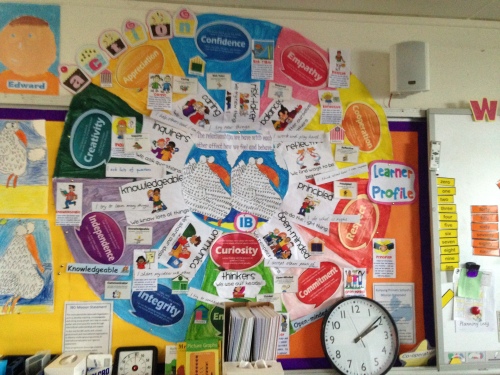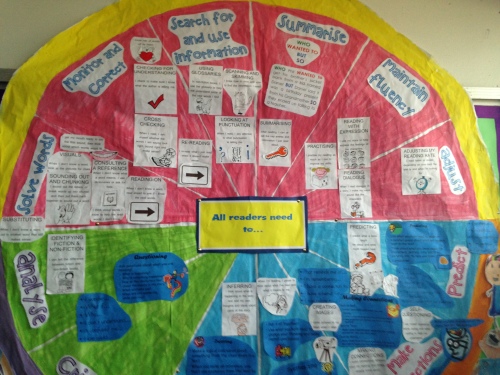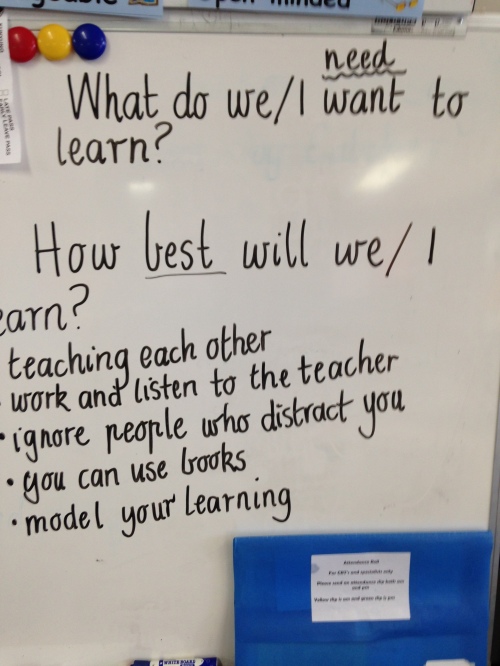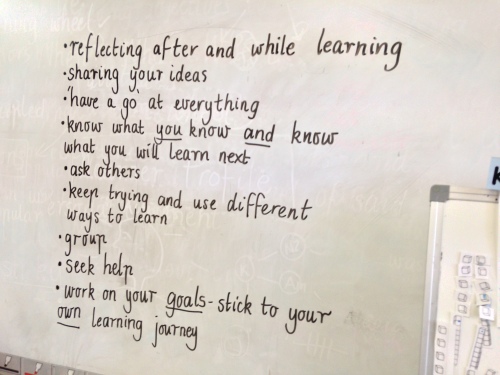This year the class JD displays just happen to be circles or cycles. Young children make connections quickly when learning representations have a common theme and language. This year across my school and for all curriculum areas we have a common Learning Cycle which students know and use.
Photo 1: The IB Learner Profile
Photo 2: The Fountas and Pinnell Reading Wheel
Photo 3: My school’s Learning Cycle which is displayed in every classroom and part of daily teaching. Our Learner Cycle is developing its own look, but essentially it’s the same whether laminated or not. Each part of the Learner Cycle is unpacked with students … and when they are learning they need to be able to articulate (deeply) the following.
What do we/I want to learn?
How best will I/we learn?
How will I know that we/I have learned?
Photo 4 & 5: How best we will learn? Unpacked by students
Young children when exposed to a learning rich diet are able feedback their insightful and unique understanding without prompting. The language of learning has to be used authentically and lived through daily actions to become embedded in the classroom and students.
Photo 6: On its way… The Writing Cycle in four pizza slices! Each pizza slice will encompass one aspect of writing e.g. the writing cycle, word work etc… You can’t eat one slice at a time, you have to constantly nibble at each slice!
Cheers Nina







From an international school in Hanoi, I am thankful to have discovered your blog, Nina. I work with grade 4 students who are learning to speak, read, write and listen to English. Your reading pizza will be a focus for me beginning next year. The temptation is to start in January and shove the whole pizza down the kids’ throats by June. I won’t make that pedagogical error. 🙂 Thanks for sharing your expertise. I LOVE the photos. Really make learning visual.
Hi Jeni, I love your comment about the pizza! We have to remember our young learners and not overload them. Cheers Nina
Hi! This is a great resource. We are looking at my school to create this based on your wonderful post. Do you have a copy of the items that you put into each action? : )
Hi, This diagram is in the front of the Fountas and Pinnell book. I can’t remember where the text stuck on it came from but they would be easily made. I used this to unpack each piece of pizza over a year. Each part was unpacked so the students had a deep understanding. We then made connections between each. The Fountas and Pinnell wheel was large and a great visual for me and the children.
Cheers Nina
Hi Nina,
It’s fantastic to see younger students identifying the ways that they learn best and then using these strategies successfully. Self reflection is such a valuable skill to develop, thank you for sharing your positive results 🙂
Also your pizza idea for writing is great.. maybe an option is to use toppings as an alternative to slices? eg the pizza base is paragraph structure (provides cohesion to link all other components together), different toppings could represent different writing features (like salami for adjectives etc) and the cheese topping could be the editing?
Thanks again
Annette
Hi Annette,
Yes, these are very young children and they are able to talk about their learning needs. The pizza was a way of making learning visible and I actually thought about having the toppings as an alternate to slices (after the event). The slices are actually a bit limiting but the toppings is a great idea for next time. Thank you so much for visiting and commenting and the ideas. You have me thinking! 🙂
Cheers Nina
Can’t wait to see what this pizza looks like! In all seriousness though, I’m captivated by the way your kids unpacked what learning looks like. This is tough, sophisticated work for little ones. I agree: when we make learning transparent and explicit, and when we create and share a common language for it, even our youngest learners can understand it, reflect on it, and thrive. This is inspiring work, Nina!
Hi Angela,
Building this learning culture takes time but it’s definitely worth it. My Year 2 students are setting their own writing goals based on their needs. They reflect on their writing and are able to set their own learning goal. They amaze me! One student did their own personal inquiry into paragraphing and has nailed it! When they share their learning with each other you’d be wowed by their maturity and ability to articulate their own needs. They’ll ask other students for feedback and make changes accordingly because that’s what good writers do.
The writing pizza: One slice will be the editing cycle, one word work and I’m still thinking about the other slices. I can have more slices… laughing! Any suggestions welcome!
Cheers Nina